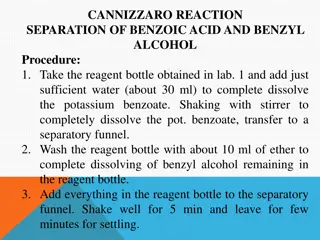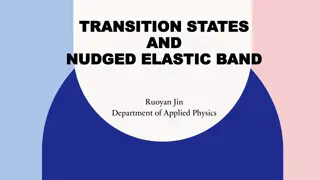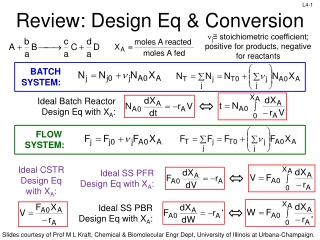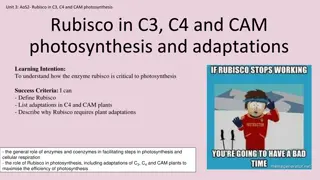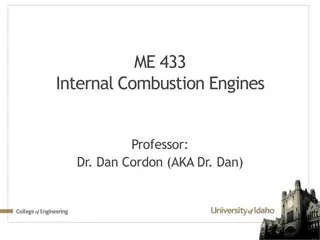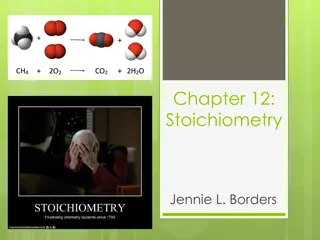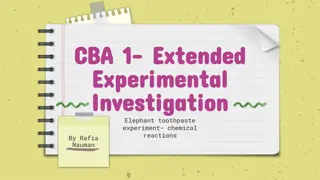Cannizzaro Reaction
The Cannizzaro reaction is a chemical reaction involving the base-induced disproportionation of non-enolizable aldehydes to form a primary alcohol and a carboxylic acid. Discover more about this reaction, its history, mechanism, and variants like the Cross Cannizzaro reaction and Intramolecular Cannizzaro reaction. Learn about the preparation methods, properties of benzyl alcohol, and a step-by-step procedure for conducting the Cannizzaro reaction.
Download Presentation
Please find below an Image/Link to download the presentation.
The content on the website is provided AS IS for your information and personal use only. It may not be sold, licensed, or shared on other websites without obtaining consent from the author. Download presentation by click this link. If you encounter any issues during the download, it is possible that the publisher has removed the file from their server.
Presentation Transcript
Reaction type Organic redox reaction Cannizzaro Reaction
CANNIZZARO REACTION The Cannizzaro reaction, named after its discoverer Stanislao Cannizzaro, is a chemical reaction which involves the base- induced disproportionation of two molecules of a non- enolizable aldehyde to give a primary alcohol and a carboxylic acid
Cannizzaro first accomplished this transformation in 1853, when he obtained benzyl alcohol and potassium benzoate from the treatment of benzaldehyde with potash (potassium carbonate). More typically, the reaction would be conducted with sodium hydroxide or potassium hydroxide, giving the sodium or potassium carboxylate salt of the carboxylic-acid product: 2 C6H5CHO + KOH C6H5CH2OH + C6H5COOK The process is a redox reaction involving transfer of a hydride from one substrate molecule to the other: one aldehyde is oxidized to form the acid, the other is reduced to form the alcohol
CROSS CANNIZZARO REACTION If an aldehyde without alpha hydrogen is reacted with formaldehyde in the presence of a strong base to form formic acid and alcohol, this reaction is known as the cross Cannizzaro reaction. Here, formaldehyde acts as a reductant and is mixed with another aldehyde molecule for the production of the required alcohol. In this reaction, the complete transformation of the two different reactants takes place to give the desired product.
INTRAMOLECULAR CANNIZZARO REACTION Intramolecular cannizzaro reaction of phenyl glyoxal to give Mandelic acid
PROCEDURE: Wash the reagent bottle Put 3 g of KOH. Add 2ml tap water. Cool the solution (Canizzaro reaction is exothermic). Add 3ml of benzaldehyde. Shake 10-15 min until thick white emulsion formed. Allow the mixture above to stand to the next lab by which time the reaction should have been completed.
PROPERTIES OF BENZYL ALCOHOL . Colorless to very fine yellow (due to oxidation) oily liquid. Immiscible with water, miscible with organic solvents like ether. Boiling point is 204-207 C
PROPERTIES OF BENZOIC ACID White crystalline plates or needles. Sparingly soluble in water, soluble in hot boiled water. Volatile with steam (so can be purified by sublimation). Reacts with sod. bicarbonate to give CO2 gas Melting point is 121-123 C.
USES BOTH ALCOHOLS AND ORGANIC ACIDS ARE WELL KNOWN FOR THEIR BIOLOGICAL ACTIONS. Benzyl alcohol has some local anaesthetic properties, it is useful as antipruretic and is the reason for its inclusion in some dental remedies and injectable in pharmaceutical preparations intended for local application, benzyl alcohol has been used up to 10 % in ointments as antipruretic and to prevent secondary infections. Antibacterial properties. Preservatives for food and pharmaceutical local application as antiseptics. In injectable, it is included in many painful IM injectable, both as a preservative and as a local anesthetic. On the other hand, benzoic acid is used as a food preservative as a free acid, or in the form of sodium salt, also used externally in form of lotions, ointments, mouth washes, etc.
SEPARATION FUNNEL A separatory funnel, also known as a separation funnel,separating funnel, or colloquially sep funnel, is a piece of laboratory glassware used in liquid-liquid extractions to separate (partition) the components of a mixture into two immiscible solvent phases of different densities.[1]Typically, one of the phases will be aqueous, and the other a lipophilic organic solvent such as ether,MTBE,dichloromethane,chloroform, or ethyl acetate. All of these solvents form a clear delineation between the two liquids.
SEPARATION A separation process is a method that converts a mixture or a solution of chemical substances into two or more distinct product mixtures. Separation processes are primarily based on physical means and some on physico-chemical means. Among the common separation processes are. Evaporation. Evaporation. Absorption. Crystallization. Filtration.
SEPARATION OF BENZOIC ACID AND BENZYL ALCOHOL Procedure: . Take the reagent bottle obtained in lab. 1 and add just sufficient water (about 10 ml) to complete dissolve the sod. benzoate. Shaking with stirrer to completely dissolve the sod. benzoate, transfer to a separatory funnel. . Wash the reagent bottle with about (5-10) ml of ether to complete dissolving of benzyl alcohol remaining in the reagent bottle. Add everything in the reagent bottle to the separatory funnel. Shake well for 5 min and leave for few minutes for settling. . It will be separated into 2 layers: aqueous later which contains benzoic acid as sod. benzoate and ethereal layer which contains benzyl alcohol and unreacted benzaldehyde. Take the ethereal layer and shake twice with 3-ml portions of saturated solutions of sod. bisulfate NaHSO3 to remove any excess or unreacted benzaldehyde.
2NaHSO3 Na2S2O3 + H2O
6. Separate the oily liquid from the aqueous NaHSO3 solution. Wash this oily liquid with 5 ml of 10 % Na2CO3 to ensure complete removal of the bisulfate solution. Na2CO3+ 2NaHSO3 CO2 + H2O + 2NaSO3 ex. sod. bisulfitesod. Sulfite in ether layer 7. Wash with 5 ml of water. Separate the oily liquid once more and dry over anhydrous sod. sulfate (or calcium chloride) to absorb any moisture (act as drying agents). **There are other compounds used as drying agents as: anhydrous magnesium sulfate MgSO4 or anhydrous pot. carbonate K2CO3. 8. Pour the watery layer into dilute H2SO4 (about 75 ml) and check with litmus paper till convert to red color (acidic solution) leading to formation of white ppt of benzoic acid. 9. Cool and filter the ppt by filter paper to get benzoic acid. Ar-COO-K + + H2SO4 (dil) Ar-COOH + KHSO4 ****We prevent excess dilute H2SO4 to avoid dissolving of benzoic acid (like dissolve like).
Reagent bottle (emulsion) Add 30 ml water + 10 ml ether (in separatory funnel). Ether Benzyl alcohol + unreacted benzaldehyde Water Dilute H2SO4 (about 75 ml) (litmus paper) to red. NaHSO3 sol Benzoic acid ppt on filter paper Filtrate K2SO4 + H2O Ether Water Na2CO3 + 2NaHSO3 CO2 + H2O + 2NaSO3 Na2CO3 sol to get rid of excess bisulfate Ether The add drying agent (to absorb any moisture) like anhydrous sod. sulfate then distillation to get benzyl alcoho Ether Water Water Water
RECRYSTALLIZATION OF BENZOIC ACID Procedure: Benzoic acid can be purified by recrystallization from water because of its high solubility in hot water and poor solubility in cold water, the avoidance of organic solvents for the recrystallization makes this experiment particularly safe. Other possible recrystallization solvents include acetic acid (anhydrous or aqueous), benzene, petroleum ether, and a mixture of ethanol and water.
Synthesis of benzyl alcohol and benzoic acid (Cannizzaro reaction) - YouTube https://www.youtube.com/watch?v=3CWa7w8zZNM


